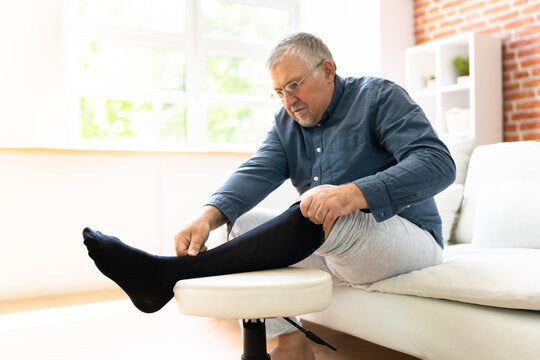
The Importance of Proper Fit in Compression Socks with a Zipper
Share
In our pursuit of better health, we often overlook the crucial role our legs play in our overall well-being. However, maintaining proper blood circulation in the legs can have a significant impact on our health. Compression socks with a zipper are a remarkable innovation that provides comfort while improving blood flow, thereby reducing the risk of leg-related ailments. Nevertheless, it is vital to understand the importance of a proper fit when choosing compression socks with a zipper. In this article, we will explore why getting the right fit matters and how it can enhance your overall health.
The Magic of Compression Socks:
Compression socks with a zipper are not your average socks. They apply pressure to the legs, promoting blood circulation and preventing blood from pooling in the lower extremities. This compression acts as a gentle massage, keeping your legs energized, reducing fatigue, and minimizing swelling. Whether you spend long hours on your feet or have a sedentary lifestyle, these socks can provide a refreshing boost.
Finding the Perfect Fit:
To fully benefit from compression socks with a zipper, finding the perfect fit is crucial. Follow these steps:
- Accurate Measurements: Measure your ankle, calf, and thigh circumference to determine the right size. Aim for a snug fit, not a tight one.
- Consult the Size Chart: Different brands may have slight variations in their size charts, so refer to the manufacturer's guidelines. Pay attention to the measurements and recommendations provided.
- Consider Compression Levels: Compression socks come in various pressure levels, ranging from mild to firm. Consult a healthcare professional or refer to the recommended compression level based on your needs. Start with a lower level and gradually increase if necessary.
Benefits of Proper Fit:
Compression socks with a proper fit offer numerous benefits, including:
- Enhanced Blood Circulation: The right fit ensures optimal pressure distribution, improving blood flow and preventing conditions like varicose veins, deep vein thrombosis, and leg ulcers.
- Reduced Muscle Fatigue: Compression socks support your muscles, reducing vibration during movement and minimizing fatigue. This is especially beneficial for athletes or those who engage in physical activities regularly.
- Decreased Swelling: A snug fit in compression socks prevents the accumulation of excess fluid in the legs, reducing swelling and discomfort.
- Quick Recovery: Properly fitting compression socks can speed up muscle recovery by promoting the efficient removal of metabolic waste products.
Choosing the Right Material:
When considering compression socks, pay attention to the material for both effectiveness and comfort. Look for breathable, moisture-wicking fabrics like nylon, spandex, or a blend of these materials. These fabrics help keep your legs dry, prevent odor, and ensure maximum comfort.
Putting On and Taking Off:
Proper technique for putting on and taking off compression socks ensures a proper fit and maximizes their benefits. Follow these steps:
- Putting on: Fold the sock inside out, ensuring the zipper is fully open. Place your hand inside the sock, hold the heel, and slide your foot in. Gently pull the sock up your leg, ensuring a comfortable and snug fit. Finally, zip it up securely.
- Taking off: Unzip the sock completely before removing it. Gradually roll it down your leg, using your fingertips to prevent excessive tension. Avoid forcefully pulling it off, as this can damage the fabric or compromise elasticity.
Professional Guidance:
If you have any pre-existing medical conditions or concerns, it is wise to consult with a healthcare professional before using compression socks with a zipper. They can provide personalized recommendations based on your specific needs and help you choose the appropriate compression level.
Maintenance and Care:
To ensure the longevity and effectiveness of your compression socks, proper maintenance is crucial. Follow these tips:
- Wash Regularly: Hand wash your compression socks with mild detergent and air dry them. Avoid using harsh chemicals or fabric softeners that can damage the fabric.
- Replace as Needed: Compression socks gradually lose elasticity over time, so replace them when they no longer provide adequate compression or show signs of wear and tear.
FAQs:
Q: Can I wear compression socks overnight?
A: It is generally safe to wear compression socks while sleeping, especially if recommended by a healthcare professional. However, it is essential to ensure they are properly fitted and comfortable.
Q: Are compression socks suitable for pregnant women?
A: Compression socks can be beneficial for pregnant women to alleviate swelling and discomfort in the legs. However, it is important to consult with a healthcare professional for proper guidance and fit.
Q: Can compression socks help with restless leg syndrome?
A: Compression socks may provide relief for individuals with restless leg syndrome by promoting better blood circulation and reducing discomfort. Consult with a healthcare professional for personalized advice.
Conclusion:
Understanding the importance of a proper fit in compression socks with a zipper is crucial for maximizing their benefits. Take accurate measurements, consult the size chart, and consider compression levels to find the right fit. With the perfect fit, compression socks enhance blood circulation, reduce muscle fatigue, decrease swelling, and aid in quick recovery. Remember to choose the right material, follow the correct technique for putting on and taking off, seek professional guidance when needed, and properly maintain your compression socks. Invest in the care your legs deserve and embrace the comfort and health benefits of compression socks with a zipper.
"Experience the true power of compression socks with a perfect fit. Feel the difference and step into a healthier, more vibrant life!"
